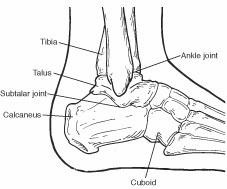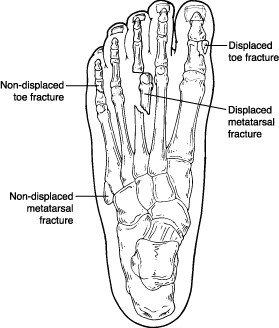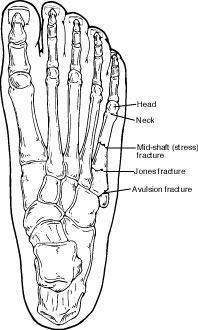Fractures
The most common fractures are fractures of the Calcaneus (Heel Bone), and toe and metatarsal fractures.
What is the Calcaneus?
The calcaneus, also called the heel bone, is a large bone that  forms the foundation of the rear part of the foot. The calcaneus connects with the talus and cuboid bones. The connection between the talus and calcaneus forms the subtalar joint. This joint is important for normal foot function.
forms the foundation of the rear part of the foot. The calcaneus connects with the talus and cuboid bones. The connection between the talus and calcaneus forms the subtalar joint. This joint is important for normal foot function.
The calcaneus is often compared to a hard boiled egg, because it has a thin, hard shell on the outside and softer, spongy bone on the inside. When the outer shell is broken, the bone tends to collapse and become fragmented. For this reason, calcaneal fractures are severe injuries. Furthermore, if the fracture involves the joints, there is the potential for long-term consequences such as arthritis and chronic pain.
How do Calcaneal Fractures Occur?
Most calcaneal fractures are the result of a traumatic event—most commonly, falling from a height, such as a ladder, or being in an automobile accident where the heel is crushed against the floorboard. Calcaneal fractures can also occur with other types of injuries, such as an ankle sprain. A smaller number of calcaneal fractures are stress fractures, caused by overuse or repetitive stress on the heel bone.
Types of Calcaneal Fractures
Fractures of the calcaneus may or may not involve the subtalar and surrounding joints. Fractures involving the joints (intra-articular fractures) are the most severe calcaneal fractures, and include damage to the cartilage (the connective tissue between two bones). The outlook for recovery depends on how severely the calcaneus was crushed at the time of injury.
Fractures that don’t involve the joint (extra-articular fractures) include:
- Those caused by trauma, such as avulsion fractures (in which a piece of bone is pulled off of the calcaneus by the Achilles tendon or a ligament) or crush injuries resulting in multiple fracture fragments
- Stress fractures, caused by overuse or mild injury.
The severity and treatment of extra-articular fractures depend on their location and size.
Signs and Symptoms
Calcaneal fractures produce different signs and symptoms, depending on whether they are traumatic or stress fractures. The signs and symptoms of traumatic fractures may include:
- Sudden pain in the heel and inability to bear weight on that foot
- Swelling in the heel area
- Bruising of the heel and ankle
The signs and symptoms of stress fractures may include:
- Generalized pain in the heel area that usually develops slowly (over several days to weeks)
- Swelling in the heel area
Diagnosis
To diagnose and evaluate a calcaneal fracture, the foot and ankle surgeon will ask questions about how the injury occurred, examine the affected foot and ankle, and order x-rays. In addition, advanced imaging tests are commonly required.
Treatment
Treatment of calcaneal fractures is dictated by the type of fracture and extent of the injury. The foot and ankle surgeon will discuss with the patient the best treatment—whether surgical or non-surgical—for the fracture.
For some fractures, non-surgical treatments may be used. These include:
- Rest, ice, compression, and elevation (R.I.C.E.) Rest (staying off the injured foot) is needed to allow the fracture to heal. Ice reduces swelling and pain; apply a bag of ice covered with a thin towel to the affected area. Compression (wrapping the foot in an elastic bandage or wearing a compression stocking) and elevation (keeping the foot even with or slightly above the heart level) also reduce the swelling.
- Immobilization. Sometimes the foot is placed in a cast or cast boot to keep the fractured bone from moving. Crutches may be needed to avoid weightbearing.
For traumatic fractures, treatment often involves surgery to reconstruct the joint, or in severe cases, to fuse the joint. The surgeon will choose the best surgical approach for the patient.
Rehabilitation
Whether the treatment for a calcaneal fracture has been surgical or non-surgical, physical therapy often plays a key role in regaining strength and restoring function.
Complications of Calcaneal Fractures
Calcaneal fractures can be serious injuries that may produce lifelong problems. Arthritis, stiffness, and pain in the joint frequently develop. Sometimes the fractured bone fails to heal in the proper position. Other possible long-term consequences ofcalcaneal fractures are decreased ankle motion and walking with alimp due to collapse of the heel bone and loss of length in the leg. Patients often require additional surgery and/or long term or permanent use of a brace or an orthotic device (arch support) to help manage these complications.
Toe and Metatarsal Fractures (Broken toes)

The structure of the foot is complex, consisting of bones, muscles, tendons, and other soft tissues. Of the 26 bones in the foot, 19 are toe bones (phalanges) and metatarsal bones (the long bones in the midfoot). Fractures of the toe and metatarsal bones are common and require evaluation by a specialist. A foot and ankle surgeon should be seen for proper diagnosis and treatment, even if initial treatment has been received in an emergency room.
What Is a Fracture?
A fracture is a break in the bone. Fractures can be divided into two categories: traumatic fractures and stress fractures.
Traumatic fractures (also called acute fractures) are caused by a direct blow or impact, such as seriously stubbing your toe. Traumatic fractures can be displaced or non-displaced. If the fracture is displaced, the bone is broken in such a way that it has changed in position (dislocated). Signs and symptoms of a traumatic fracture include:
- You may hear a sound at the time of the break.
- “Pinpoint pain” (pain at the place of impact) at the time the fracture occurs and perhaps for a few hours later, but often the pain goes away after several hours.
- Crooked or abnormal appearance of the toe.
- Bruising and swelling the next day.
It is not true that “if you can walk on it, it’s not broken.” Evaluation by a foot and ankle surgeon is always recommended.
Stress fractures are tiny, hairline breaks that are usually caused by repetitive stress. Stress fractures often afflict athletes who, for example, too rapidly increase their running mileage. They can also be caused by an abnormal foot structure, deformities, or osteoporosis. Improper footwear may also lead to stress fractures. Stress fractures should not be ignored. They require proper medical attention to heal correctly. Symptoms of stress fractures include:
- Pain with or after normal activity
- Pain that goes away when resting and then returns when standing or during activity
- “Pinpoint pain” (pain at the site of the fracture) when touched
- Swelling, but no bruising
Consequences of Improper Treatment
Some people say that “the doctor can’t do anything for a broken bone in the foot.” This is usually not true. In fact, if a fractured toe or metatarsal bone is not treated correctly, serious complications may develop. For example:
- A deformity in the bony architecture which may limit the ability to move the foot or cause difficulty in fitting shoes
- Arthritis, which may be caused by a fracture in a joint (the juncture where two bones meet), or may be a result of angular deformities that develop when a displaced fracture is severe or hasn’t been properly corrected
- Chronic pain and deformity
- Non-union, or failure to heal, can lead to subsequent surgery or chronic pain.
Treatment of Toe Fractures
Fractures of the toe bones are almost always traumatic fractures. Treatment for traumatic fractures depends on the break itself and may include these options:
- Rest. Sometimes rest is all that is needed to treat a traumatic fracture of the toe.
- Splinting. The toe may be fitted with a splint to keep it in a fixed position.
- Rigid or stiff-soled shoe. Wearing a stiff-soled shoe protects the toe and helps keep it properly positioned.
- “Buddy taping” the fractured toe to another toe is sometimes appropriate, but in other cases it may be harmful.
- *Surgery. If the break is badly displaced or if the joint is affected, surgery may be necessary. Surgery often involves the use of fixation devices, such as pins.
Metatarsal Fractures

Breaks in the metatarsal bones may be either stress or traumatic fractures. Certain kinds of fractures of the metatarsal bones present unique challenges.
For example, sometimes a fracture of the first metatarsal bone (behind the big toe) can lead to arthritis. Since the big toe is used so frequently and bears more weight than other toes, arthritis in that area can make it painful to walk, bend, or even stand.
Another type of break, called a Jones fracture, occurs at the base of the fifth metatarsal bone (behind the little toe). It is often misdiagnosed as an ankle sprain, and misdiagnosis can have serious consequences since sprains and fractures require different treatments. Your foot and ankle surgeon is an expert in correctly identifying these conditions as well as other problems of the foot.
Treatment of metatarsal fractures depends on the type and extent of the fracture, and may include:
- Rest. Sometimes rest is the only treatment needed to promote healing of a stress or traumatic fracture of a metatarsal bone.
- Avoid the offending activity. Because stress fractures result from repetitive stress, it is important to avoid the activity that led to the fracture. Crutches or a wheelchair are sometimes required to offload weight from the foot to give it time to heal.
- Immobilization, casting, or rigid shoe. A stiff-soled shoe or other form of immobilization may be used to protect the fractured bone while it is healing.
- Surgery. Some traumatic fractures of the metatarsal bones require surgery, especially if the break is badly displaced.
- Follow-up care. Your foot and ankle surgeon will provide instructions for care following surgical or non-surgical treatment. Physical therapy, exercises and rehabilitation may be included in a schedule for return to normal activities.
This information is copyrighted by The American College of Foot and Ankle Surgeons.
